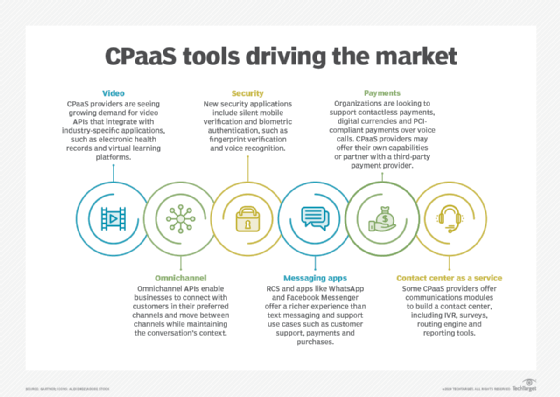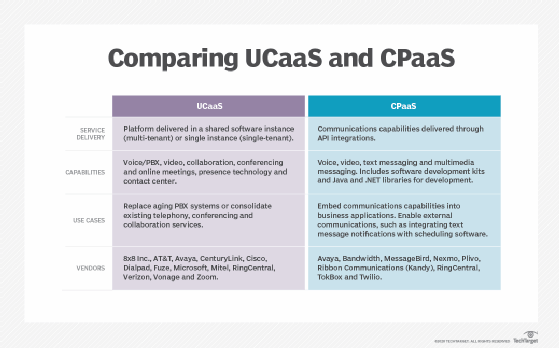communications platform as a service (CPaaS)
What is communications platform as a service (CPaaS)?
Communications platform as a service is a cloud-based delivery model that allows organizations to add real-time communications capabilities, such as voice, video and messaging, to business applications by deploying application program interfaces (APIs).
The communication capabilities delivered by APIs include SMS (Short Message Service), MMS (Multimedia Messaging Service), telephony and video. Communication services can be embedded into business applications, such as sales software, to add features such as notifications, click-to-call and multifactor authentication (MFA).
CPaaS is deployed by organizations that want to embed communications in their business applications, as well as cloud service providers and developers looking to add communications capabilities to their applications and services.
The platforms include standards-based APIs, comprehensive software development kits (SDKs), and Java or .NET libraries for building applications on various platforms. CPaaS providers can also offer bundles that provide prepackaged, fully functional communication features that can be dropped into applications.
This article is part of
What is PaaS? Platform as a service definition and guide
The CPaaS market was originally driven by startups, such as Twilio, TokBox and Plivo, which offer APIs for embedding communications. Legacy unified communications (UC) vendors have entered the market with new services, including Avaya's Breeze. Other vendors have acquired startups, such as Cisco acquiring Tropo and Vonage acquiring Nexmo.

How CPaaS works
The purpose of CPaaS is for developers to be able to add real-time communications features to a company's existing business application. Rather than using applications created specifically for communications purposes -- such as Microsoft Teams or Skype -- CPaaS allows these features (such as live chat, SMS, voice or video calling) to be integrated into business applications with other primary functions.
Third-party CPaaS services allow in-house developers to incorporate these features, typically by providing tools such as standards-based APIs, sample code and prebuilt applications. Some services may even offer software development kits with libraries.
As a cloud computing service, CPaaS allows these communications features to be added to applications without companies having to invest in building their own back-end infrastructures.
CPaaS is typically billed on a monthly basis at a fixed rate for blocks of messages or minutes. Some CPaaS providers offer a pay-per-call, per-video or per-message billing model. Rather than developing their own custom applications, CPaaS offers organizations a faster and lower-cost alternative to enable communications in applications.
Early CPaaS deployments have focused on applications in Telehealth, field services, education, customer service, call centers and social media. CPaaS-enabled applications may include features like video-enabled help desks, in-app messaging and authentication services.
Read more about platform as a service
SaaS vs. IaaS vs. PaaS: Differences, Pros, Cons and Examples
6 open source PaaS options developers should know
PaaS and containers: Key differences, similarities and uses
The state of the PaaS business model and market
Test your platform-as-a-service knowledge with this PaaS quiz
Benefits of communications platform as a service
The implementation of a CPaaS service has numerous benefits:
- In-house developers can customize specific application communications features, in accordance with their broader digital transformation strategy. This also provides control over the user experience (UX) and customer engagement.
- Existing business applications do not need to be replaced.
- Typically comes with technical support for in-house developers building the applications, such as online guides, forums for answers and live support.
- Allows developers to focus on building applications as opposed to underlying IT infrastructures.
- Cloud-hosted platforms allow for scalability.
- Cost savings on infrastructure overhead and maintenance costs.
- Faster time to market for applications.
- Customers won't need to pay for any more services than used.
- Allows Multi-tenancy within secure cloud environments.
The difference between CPaaS vs. UCaaS
Because CPaaS and unified communications as a service (UCaaS) both focus on developing flexible, modern cloud communications systems and contain overlap in functionalities, they can be easily confused. The primary difference is in how the providers deliver essential services to their clients.
The purpose of UCaaS is to have a single ready-made platform through which clients access different services, such as phone, video calling, call recording and so on.
CPaaS is more of a "build your own" type of model. CPaaS is an open foundational platform where a client's in-house developer simply uses ready-made APIs to build features. Vendors with more comprehensive offerings may also include sample code, modules, wrappers and SDKs for less experienced developers.

Understanding the types of CPaaS providers
CPaaS providers come from a variety of backgrounds and business models. Gartner classifies vendors in the CPaaS market in one of five categories.
- Pure-play vendors. These are more-established vendors in the CPaaS market, with service offerings beyond simpler SMS and voice APIs. These services support additional communication channels and also feature extended APIs and modules. They have more comprehensive sets of tools for developers. Vendors that fall into this category include Twilio, Vonage-Nexmo, Plivo, Sinch, MessageBird, and Infobip.
- Vendors who specialize in SMS, application-to-person (A2P) and person-to-application (P2A). These vendors have expanded beyond their area of specialization into the growing CPaaS market. Services offered by these vendors are relatively nascent, being either an early stage offering or a recent consolidation of multiple disparate services. Vendors in this market segment include Soprano Design, TeleSign, Zenvia and Kaleyra.
- Traditional enterprise communications vendors. The offerings of these vendors are created by integrating or augmenting preexisting communications solutions (such as voice/video calling) into CPaaS products. Vendors in this segment include Avaya, Alcatel-Lucent Enterprise (ALE), Plum Voice, Ytel and IntelePeer.
- Communications service providers. This category includes companies such as AT&T, with certain unique competitive advantages, such as advanced network capabilities.
- Software providers for mobile applications. This can include vendors such as IMImobile and CM.com.
Choosing a CPaaS option
While selecting a CPaaS vendor, certain considerations should be made:
- API quality and selection. Selection, depth, quality of APIs should be a primary consideration. Look for vendors with APIs that are well tested, reliable and stable. Furthermore, the programming languages that the APIs support should be considered.
- Developer learning curve. Some CPaaS vendors will offer modules and/or wrappers that cater to client developers with limited coding skills.
- Time in market. Smaller, younger CPaaS vendors are at risk for going under or getting purchased by a larger company, which could cause significant disruption to service.
- User and developer community. A healthy user community for the platform can help developers get the most out of the service's offerings.
- Network infrastructure strength. Look for vendors that can provide consistent and reliable service.
- Data security. Vendors must be able to ensure the security of valuable data. Providers should rigorously monitor the platform and applications.





